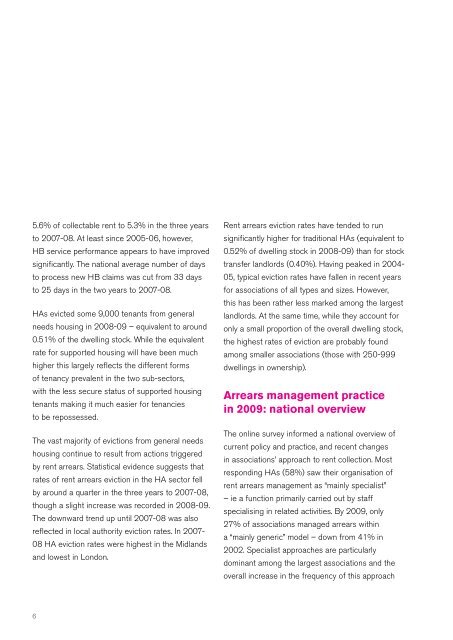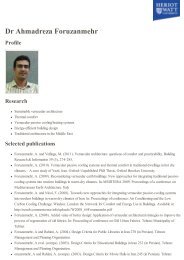Rent arrears management practices in the housing association sector
Rent arrears management practices in the housing association sector
Rent arrears management practices in the housing association sector
You also want an ePaper? Increase the reach of your titles
YUMPU automatically turns print PDFs into web optimized ePapers that Google loves.
5 .6% of collectable rent to 5 .3% <strong>in</strong> <strong>the</strong> three years<br />
to 2007-08 . At least s<strong>in</strong>ce 2005-06, however,<br />
HB service performance appears to have improved<br />
significantly . The national average number of days<br />
to process new HB claims was cut from 33 days<br />
to 25 days <strong>in</strong> <strong>the</strong> two years to 2007-08 .<br />
HAs evicted some 9,000 tenants from general<br />
needs hous<strong>in</strong>g <strong>in</strong> 2008-09 – equivalent to around<br />
0 .51% of <strong>the</strong> dwell<strong>in</strong>g stock . While <strong>the</strong> equivalent<br />
rate for supported hous<strong>in</strong>g will have been much<br />
higher this largely reflects <strong>the</strong> different forms<br />
of tenancy prevalent <strong>in</strong> <strong>the</strong> two sub-<strong>sector</strong>s,<br />
with <strong>the</strong> less secure status of supported hous<strong>in</strong>g<br />
tenants mak<strong>in</strong>g it much easier for tenancies<br />
to be repossessed .<br />
The vast majority of evictions from general needs<br />
hous<strong>in</strong>g cont<strong>in</strong>ue to result from actions triggered<br />
by rent <strong>arrears</strong> . Statistical evidence suggests that<br />
rates of rent <strong>arrears</strong> eviction <strong>in</strong> <strong>the</strong> HA <strong>sector</strong> fell<br />
by around a quarter <strong>in</strong> <strong>the</strong> three years to 2007-08,<br />
though a slight <strong>in</strong>crease was recorded <strong>in</strong> 2008-09 .<br />
The downward trend up until 2007-08 was also<br />
reflected <strong>in</strong> local authority eviction rates . In 2007-<br />
08 HA eviction rates were highest <strong>in</strong> <strong>the</strong> Midlands<br />
and lowest <strong>in</strong> London .<br />
6<br />
<strong>Rent</strong> <strong>arrears</strong> eviction rates have tended to run<br />
significantly higher for traditional HAs (equivalent to<br />
0 .52% of dwell<strong>in</strong>g stock <strong>in</strong> 2008-09) than for stock<br />
transfer landlords (0 .40%) . Hav<strong>in</strong>g peaked <strong>in</strong> 2004-<br />
05, typical eviction rates have fallen <strong>in</strong> recent years<br />
for <strong>association</strong>s of all types and sizes . However,<br />
this has been ra<strong>the</strong>r less marked among <strong>the</strong> largest<br />
landlords . At <strong>the</strong> same time, while <strong>the</strong>y account for<br />
only a small proportion of <strong>the</strong> overall dwell<strong>in</strong>g stock,<br />
<strong>the</strong> highest rates of eviction are probably found<br />
among smaller <strong>association</strong>s (those with 250-999<br />
dwell<strong>in</strong>gs <strong>in</strong> ownership) .<br />
Arrears <strong>management</strong> practice<br />
<strong>in</strong> 2009: national overview<br />
The onl<strong>in</strong>e survey <strong>in</strong>formed a national overview of<br />
current policy and practice, and recent changes<br />
<strong>in</strong> <strong>association</strong>s’ approach to rent collection . Most<br />
respond<strong>in</strong>g HAs (58%) saw <strong>the</strong>ir organisation of<br />
rent <strong>arrears</strong> <strong>management</strong> as “ma<strong>in</strong>ly specialist”<br />
– ie a function primarily carried out by staff<br />
specialis<strong>in</strong>g <strong>in</strong> related activities . By 2009, only<br />
27% of <strong>association</strong>s managed <strong>arrears</strong> with<strong>in</strong><br />
a “ma<strong>in</strong>ly generic” model – down from 41% <strong>in</strong><br />
2002 . Specialist approaches are particularly<br />
dom<strong>in</strong>ant among <strong>the</strong> largest <strong>association</strong>s and <strong>the</strong><br />
overall <strong>in</strong>crease <strong>in</strong> <strong>the</strong> frequency of this approach




